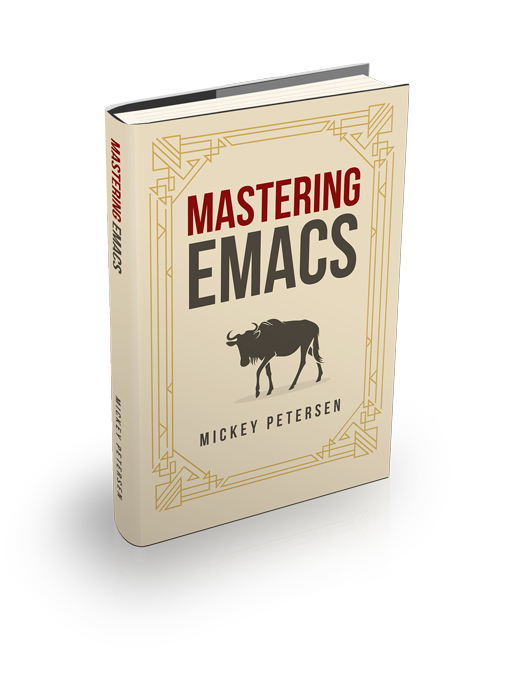Have you ever heard of use-package? It’s a declarative way of expressing package configuration in Emacs but without the tears. It’s written by the inimitable John Wiegley, a former GNU Emacs lead maintainer and author of many cool tools like a command line ledger, Emacs’s Eshell, and much more.
It’s fair to say most of us have declared .emacs bankruptcy at least once. It comes about when the passage of time and your ossified hacks-upon-hacks conspire against you, and you’re wondering why you have thousands of lines dedicated to something you haven’t touched in a decade.
Even in a post-hack world of package managers, starter kits, and sane defaults, it still sneaks up on you as you pile on more and more packages and customizations. use-package goes some way towards solving that by introducing a simple, declarative macro that – through some eldritch elisp magic – ensures your package is loaded only when it’s needed, and that its settings are loaded alongside it, in a deterministic and understandable manner.
use-package is easy to use, and it ships with a nice README.md file explaining how it works. The only thing holding back its adoption is that, before Emacs 29.1, it did not ship with Emacs. Now that it’s included, you can build your Emacs configuration “from scratch” without first having to bootstrap the installation of use-package.
Here’s an example of how you can use it. Please note that use-package is rather feature rich, and I really only touch on the basics, here. I do feel you get by with little more than the directives I show you below, though; most of the other ones allow for more advanced features, which you may not need at all.
If you regularly use Emacs’s dictionary lookup feature you may want to customize it to your liking:
(use-package dictionary
:bind (("M-#" . dictionary-lookup-definition))
:config
(setq dictionary-use-single-buffer t)
(setq dictionary-server "localhost"))Here I declare that dictionary – for that is the name of the feature in Emacs – must bind a global key, M-#, to dictionary-lookup-definition in addition to configuring a couple of variables. What’s a feature you ask? Anything that (featurep 'something) returns non-nil to. Keep an eye out for (require 'something).
One other thing about features: where do you put things that do not belong to any one feature? Well, there’s a “meta” feature called emacs just for that purpose. Use that for all the other stray bits of code you want to stash together.
You can combine your customizations with :config, :init and :preface. Each type works in a slightly different way.
The :config keyword executes the code after a package is loaded; the :init keyword executes the code before the package is loaded; and the :preface keyword is there so the Emacs byte compiler and the lisp evaluator know about things like function and symbol declarations.
My personal view is to put most things into :config (as you probably want to initialize your own settings after the package has loaded its own defaults) and only toy with :init and :preface if you have a good reason to, or you regularly define your own commands, variables or functions for use with that package.
Here’s an example where I change the default M-x re-builder – re-builder is Emacs’s regexp builder – syntax to string:
(use-package re-builder
:bind (("C-c R" . re-builder))
:config (setq reb-re-syntax 'string))You can even migrate all your hand-crafted auto-mode-alist alterations to use-package. Here I declare that .txt, .rst and .rest files must use rst-mode:
(use-package rst
:mode (("\\.txt\\'" . rst-mode)
("\\.rst\\'" . rst-mode)
("\\.rest\\'" . rst-mode)))You can use it with built-in “packages” in Emacs also. Here I re-bind certain keys and set up a hook against Emacs’s builtin terminal emulator:
(use-package term
:preface
(defun mp-term-custom-settings ()
(local-set-key (kbd "M-p") 'term-send-up)
(local-set-key (kbd "M-n") 'term-send-down))
:config
(add-hook 'term-load-hook 'mp-term-custom-settings)
(define-key term-raw-map (kbd "M-o") 'other-window)
(define-key term-raw-map (kbd "M-p") 'term-send-up)
(define-key term-raw-map (kbd "M-n") 'term-send-down))As you can see, it keeps everything nice and tidy. The older way of evaluating things after load, or even just require’ing all the packages you use and then applying your changes is completely unnecessary with use-package. use-package is clever enough to only autoload commands you’ve bound (or explicitly declared with :commands), meaning Emacs won’t load the package into memory until you actually need it. In practical terms, it should greatly speed up your Emacs start time.
Once you’ve rewired your Emacs configuration to use-package you’re going to want to jump to the requisite package definitions. To do this, enable use-package-enable-imenu-support. Now you can use Emacs’s Imenu (M-g i in Emacs 29, or just M-x imenu) to jump to the definition. Nifty!
Although it does require learning a new “mini-language”, I think use-package is worth considering if you’re even moderately organized.



